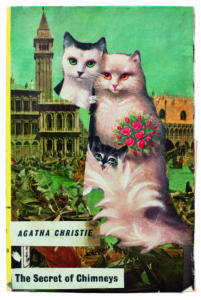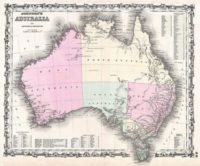These men pranked their local library. Homophobic outrage ensued. A bitter look back at a time of high stakes for creative pranksters.
“The Strange, Sad Story of Joe Orton, His Lover, and 72 Stolen Library Books”
by Natasha Frost
Atlas Obscura
August 9, 2017
 A search warrant might seem excessive for library book hoarding””but Halliwell and Orton were no ordinary library pilferers. For over two years, Orton and Halliwell had been smuggling books out of their local libraries, the magnificent Art Nouveau Islington Central Library on London”™s Holloway Road and nearby red-brick Essex Road Library””and then returning them.
A search warrant might seem excessive for library book hoarding””but Halliwell and Orton were no ordinary library pilferers. For over two years, Orton and Halliwell had been smuggling books out of their local libraries, the magnificent Art Nouveau Islington Central Library on London”™s Holloway Road and nearby red-brick Essex Road Library””and then returning them.
Orton hid books in a satchel; Halliwell, six-and-a-half years older, used a gas mask case. They would take them home, redo their covers and dust-jackets, and then slip them back onto the shelves.
Sometimes, these alterations were obscene: a reader scanning a relatively tame Dorothy Sayers whodunit would find themselves confronted with a mystery even before they opened the book. The blurb now described some missing knickers and a seven-inch phallus, and concluded: “READ THIS BEHIND CLOSED DOORS! And have a good s*** while you are reading!” Meanwhile, the collected plays of Emlyn Williams, a Welsh dramatist, suddenly included “Knickers Must Fall,” “Olivia Prude,” “Up The Front,” and “Up The Back.” Read more.

 Move aside quokkas and black swans, Perth is now home to the world”™s smartest dog, at least on paper.
Move aside quokkas and black swans, Perth is now home to the world”™s smartest dog, at least on paper. That”™s how we began. We used this preposterous sentence to open a “paper” consisting of 3,000 words of utter nonsense posing as academic scholarship. Then a peer-reviewed academic journal in the social sciences accepted and published it.
That”™s how we began. We used this preposterous sentence to open a “paper” consisting of 3,000 words of utter nonsense posing as academic scholarship. Then a peer-reviewed academic journal in the social sciences accepted and published it. In 1977, art historian and pioneer computer artist Lillian Schwartz made a remarkable observation with potentially far-reaching implications for the Shakespeare authorship debate.
In 1977, art historian and pioneer computer artist Lillian Schwartz made a remarkable observation with potentially far-reaching implications for the Shakespeare authorship debate.
 In 1943, fed up with modernist poetry, two Australian servicemen invented a fake poet and submitted a collection of deliberately senseless verses to a Melbourne arts magazine. To their delight, they were accepted and their author hailed as “one of the most remarkable and important poetic figures of this country.” In this week”™s episode of the Futility Closet podcast we”™ll tell the story of the Ern Malley hoax, its perpetrators, and its surprising legacy in Australian literature.
In 1943, fed up with modernist poetry, two Australian servicemen invented a fake poet and submitted a collection of deliberately senseless verses to a Melbourne arts magazine. To their delight, they were accepted and their author hailed as “one of the most remarkable and important poetic figures of this country.” In this week”™s episode of the Futility Closet podcast we”™ll tell the story of the Ern Malley hoax, its perpetrators, and its surprising legacy in Australian literature.